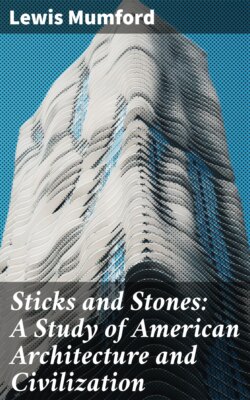Читать книгу Sticks and Stones: A Study of American Architecture and Civilization - Lewis Mumford - Страница 10
На сайте Литреса книга снята с продажи.
II
ОглавлениеTable of Contents
The Renaissance was an orientation of the European mind towards the forms of Roman and Greek civilization, and towards the meaning of classical culture. On the latter side its impulse was plainly a liberating one: it delivered the human soul from a cell of torments in which there were no modulating interests or activities between the base satisfactions of the temporal life and the beatitudes of heaven. With the Renaissance the god-beast became, once again, a man. Moreover, just when the Catholic culture of Christendom was breaking down under the influence of heresy and skepticism, the classics brought to the educated men of Europe a common theme which saved them from complete intellectual vagrancy. The effect of classical civilization, on the other hand, was not an unmixed good: for it served all too quickly to stereotype in old forms a spirit which had been freshly reborn, and it set up a servile principle in the arts which has in part been responsible for the wreck of both taste and craftsmanship.
The first builders of the Renaissance, in Italy, were not primarily architects; they were rather supreme artists in the minor crafts; and their chief failing was, perhaps, that they wished to stamp with their personal imprint all the thousand details of sculpture, painting, and carving which had hitherto been left to the humble craftsman. Presently, the technical knowledge of the outward treatment of a building became a touchstone to success; and a literal understanding of the products of antiquity took the place in lesser men of personal inspiration. The result was that architecture became more and more a thing of paper designs and exact archæological measurements; the workman was condemned to carry out in a faithful, slavish way the details which the architect himself had acquired in similar fashion. So the architect ceased to be a master-builder working among comrades of wide experience and travel: he became a Renaissance gentleman who merely gave orders to his servants.
Victor Hugo said in Notre Dame that the printing-press destroyed architecture, which had hitherto been the stone record of mankind. The real misdemeanor of the printing-press, however, was not that it took literary values away from architecture, but that it caused architecture to derive its value from literature. With the Renaissance the great modern distinction between the literate and the illiterate extends even to building; the master mason who knew his stone and his workmen and his tools and the tradition of his art gave way to the architect who knew his Palladio and his Vignola and his Vitruvius. Architecture, instead of striving to leave the imprint of a happy spirit on the superficies of a building, became a mere matter of grammatical accuracy and pronunciation; and the seventeenth-century architects who revolted from this regime and created the baroque were at home only in the pleasure gardens and theaters of princes. For the common run of architects, particularly in the northern countries, the Five Orders became as unchallengeable as the eighty-one rules of Latin syntax. To build with a pointed arch was barbarous, to build with disregard for formal symmetry was barbarous, to permit the common workman to carry out his individual taste in carving was to risk vulgarity and pander to an obsolete sense of democracy. The classics had, it is true, united Europe anew in a catholic culture; but alas! it was only the leisured upper classes who could fully take possession of the new kingdom of the mind. The Five Orders remained firmly entrenched on one side, the “lower orders” on the other.
Hereafter, architecture lives by the book. First it is Palladio and Vignola; then it is Burlington and Chambers; then, after the middle of the eighteenth century, the brothers Adam and Stuart’s Antiquities of Athens. Simpler works with detailed prescriptions for building in the fashionable mode made their way in the late seventeenth century among the smaller fry of carpenters and builders; and they were widely used in America, as a guide to taste and technique, right down to the middle of the nineteenth century. It was by means of the book that the architecture of the eighteenth century from St. Petersburg to Philadelphia seemed cast by a single mind. We call the mode Georgian because vast quantities of such building was done in England, as a result of the general commercial prosperity of that country; but it was common wherever European civilization had any fresh architectural effort to make, and if we call this style “colonial” in America it is not to mark any particular lapse or lack of distinction.
The Renaissance in architecture had reached England at about the time of the Great Fire (1666), fully two generations after the Italian influence had made its way into English literature; and it came to America, as one might guess, about a generation later. It was left for Alexander Pope, who himself was a dutiful Augustan, to sum up the situation with classic precision to Lord Burlington, who had published Palladio’s Antiquities of Rome:
“You show us Rome was glorious, not profuse,
And pompous buildings once were things of use.
Yet shall, my lord, your just and noble rules
Fill half the land with imitation fools;
Who random drawings from your sheets shall take
And of one beauty many blunders make.”
These lines were a warning and a prophecy. The warning was timely; and the prophecy came true, except in those districts in which the carpenter continued to ply his craft without the overlordship of the architect.
